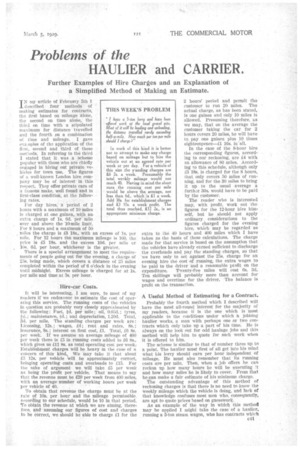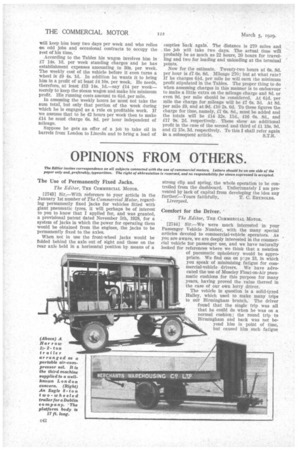Problems of the HAULIER and CARRIER.
Page 63

Page 64

If you've noticed an error in this article please click here to report it so we can fix it.
Further Examples of Hire Charges and an Explanation of a Simplified Method of Making an Estimate.
IN my article of Februa-ry 5th I described four methods of making estimates for contracts, the first based on mileage alone, the second on time alone, the third on time with a stipulated maximum for distance travelled and the fourth on a combination of time and mileage. I gave exa.nples of the application of the first, second and third of these methods. In referring to the third I stated that it was a scheme popular with those who are chiefly engaged in hiring out private vehicles for town use. The figures of a well-known. London hire company may be of interest in this respect. They offer private cars of a famous Make, well found and in first-class condition, at the follow
ing rates. • For day hires, a period of 2 hours with a maximum of 10 miles is charged at -one guinea, .with an extra charge of is. 6d. per mile over and above the '10-mile limit. For 8 hours and a niaximurn of 50 miles the charge is £3 18s., with an excess of is. per mile. For 12 hours the maximum mileage is 100, the price is £5 18s. and the excess 10(1. per mile or 10s. 6d. per hour, whichever is the greater.
There is a special arrangement to meet the requirements of people going out for the evening, a charge of 25s. being made, which covers a distance of 25 miles completed within the period of 6 o'clock in the evening until midnight. Excess mileage is charged for at is. per mile and time at 5s. per hour.
Hire-car Costs.
It will be interesting, I am sure, to most of my readers if we endeavour to estimate the cost of operating this service. The running costs of the vehicles in question are probably very closely approximated by the following: Fuel, id. per mile; oil, 0.05d.; tyres, 4(1.; maintenance, 4(1.; and depreciation, 1.200. Total, 3d. per mile. The standing charges per week are : Licensing, 12s.; wages, £.4: rent and rates, 8s.; insurance, 8s.; interest on first cost, £1. Total, £6 8s. per week. If we assume an average mileage of 400 per week there is £5 in running costs added to £6 88., which gives us 111 8s. as total operating cost per week-.Establishment charges will be heavy in the case of a concern of this kind. We may take it that about £5 12s, per vehicle will be approximately correct, bringing operating costs and overheads to £15. For the sake of argument we will take £5 per week as being the profit per vehicle. That means to say that the revenue must be £20 per week from 400 miles, with an averagenumber of working hours per week per vehicle of 40.
To obtain that revenue the charge must be at the rate of 10s. per hour and the mileage permissible, according to our schedule, would be 10 in that period. To obtain the revenue at which we are aiming, therefore, and assuming our figures of cost and charges to be correct, we should be able to charge £1 for the 2 hours' period and permit the customer to run 20 miles. The actual charge, as has been stated, is one guinea and only 10 miles is allowed. Presuming therefere,
we may, that on the average the customer taking the car for 2 hours covers 20 miles, he will have to pay one guinea plus 10 times eighteenpence-11 16s. in 'all.
In the case of the 8-hour hire the corresponding figures, according to our reckoning, are £4 with an allowance of 80 miles. According to this schedule, althottgh only £3 18s. is charged for the 8 hours, that, only covers 50 miles of running, and for the 30 miles to bring it up to the usual average a further 30s. would have to be paid by the customer.
The reader who is interested may, with profit, work out the figures for the 12-hour hire himself, but he should not apply ordinary considerations to the figures charged for the evening hire, which may be regarded as extra to . the 10 hours and 400 miles which I have taken as -the basis of these calculations. The charge made for that service is based on the assumption that the vehicles have already earned sufficient to discharge the overheads and pay the standing. charges, so that we have only to Set against the 25s. charge for an evening hire the cost of running, the extra wages to he paid to the driver and a reasonable profit on the expenditure. Twenty-five miles will cost Os. 3d. Ten shillings will probably more than account for wages and overtime for the driver. The balance is profit on the transaction.
A Useful Method of Estimating for a Contract.
Probably the fourth method which I described will have the most all-round interest for the majority of my readers, because it is the one which is most applicable to the conditions under which It jobbing haulier works, a man with perhaps one or two contracts which only take up a part of his time. He is always on the look Out for odd haulage jobs and this method will help him to quote for such work when it is offered to him.
The scheme is.similar to that of number three up to a point. The haulier must first of all get into his mind what his lorry should earn per hour independent Of mileage. He must also remember that its running costs are per mile. Then, when a job offers he can reckon up how many hours he will be executing it and bow many miles he is likely to cover. From that he can make a fair estimate of his minimum charge.
The outstanding advantage of this method of reckoning charges is that there is no need to know the weekly mileage which the vehicle is doing, and lack of that knowledge confuses most men who, consequently, are apt to quote prices based on guesswork.
As an example of the way in which this method may be applied I might take the case of a haulier, running a 5-ton steam wagon, who has contracts which e41 will keep him busy two days per week and who relies on odd jobs and occasional contracts to occupy the rest of his time.'
According to the Tables his wagon involves him in £7 14s. 10, per week standing charges and he has establishment expenses amounting to 30s. per week. The weekly cost of the vehicle before it even turns a wheel is £9 4s. 10. In addition lie wants it to bring him in a profit of at least £4 10s. per week. He needs, therefore, at least £13 14s. _ld.—say £14 per week— merely to keep the steam wagon and make his minimum profit. His running costs amount to Old. per mile.
In assessing the weekly hours he must not take the sum total, but only that portion of the week during which he is engaged as a rule on profitable work. If we assume that to be 42 hours per week then to make £14 he must charge Os. 8d. per hour independent of mileage.
Suppose he gets an offer of a job to take oil in barrels from London to Lincoln and to bring a load of empties hack again. The distance is 270 miles and the job ,will take two days. The actual time will probably be as much as 22 hours, 20 hours fel* travelling and two for loading and unloading at the terminal points.
Now for the estimate. Twenty-two hours at 6s. 80. per hour is £7 6s. 8d. Mileage 270; but at what rate? If he charges 64d. per mile he will earn the minimum profit stipulated in the Tables. The proper thing to do when assessing charges in this manner is to endeavour to make a little extra on the mileage charge and 80. or even 90. per mile should be considered. At Old. per mile the charge for mileage will be £7 Os. 3d. At 80. per mile £9, and at 9d. f10 2s. 6d. To these figures the charge for time, namely, £7 6s. 80., must be added and the totals will be £14 12s. 11d.' £16 6s. 80., and £17 9s. 2d. respectively. These show an additional profit in the case of the second and third of £1 13s. 90. and £2 15s. 3d. respectively. To this I shall refer again
in a subsequent article. S.T.R.












































































































